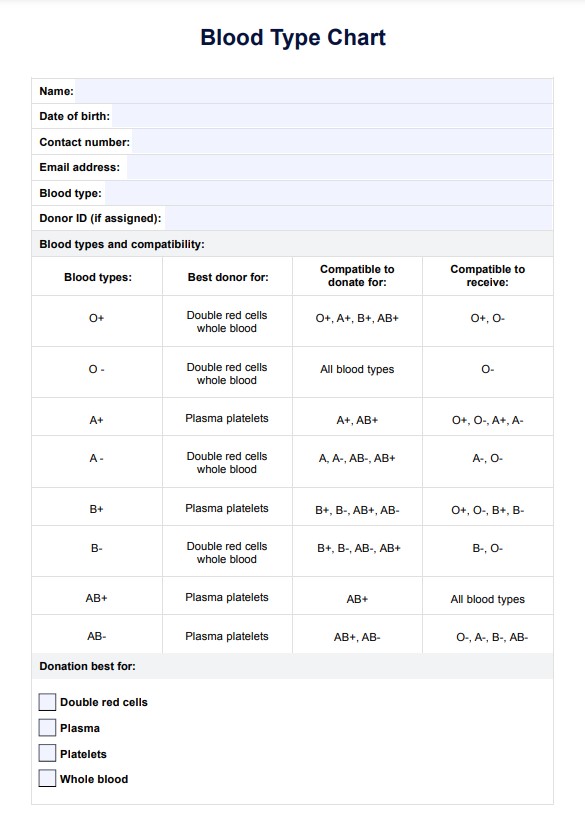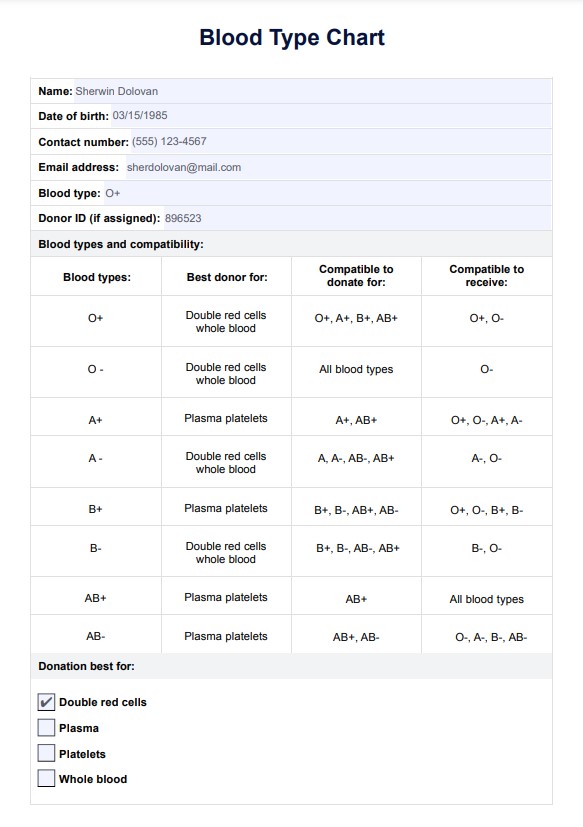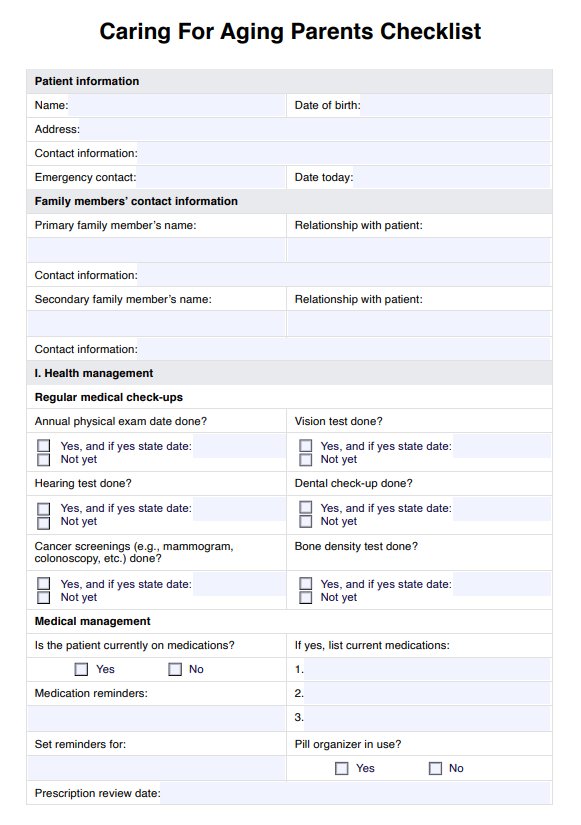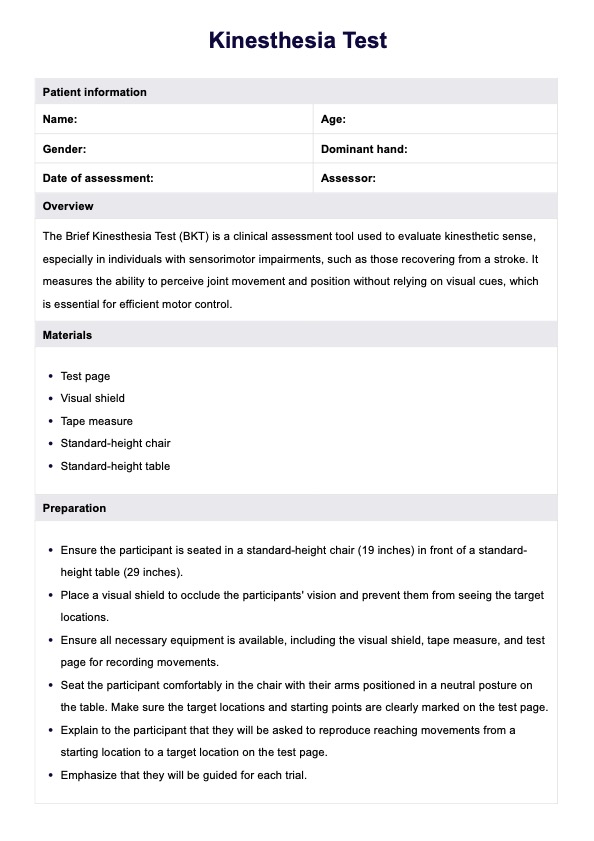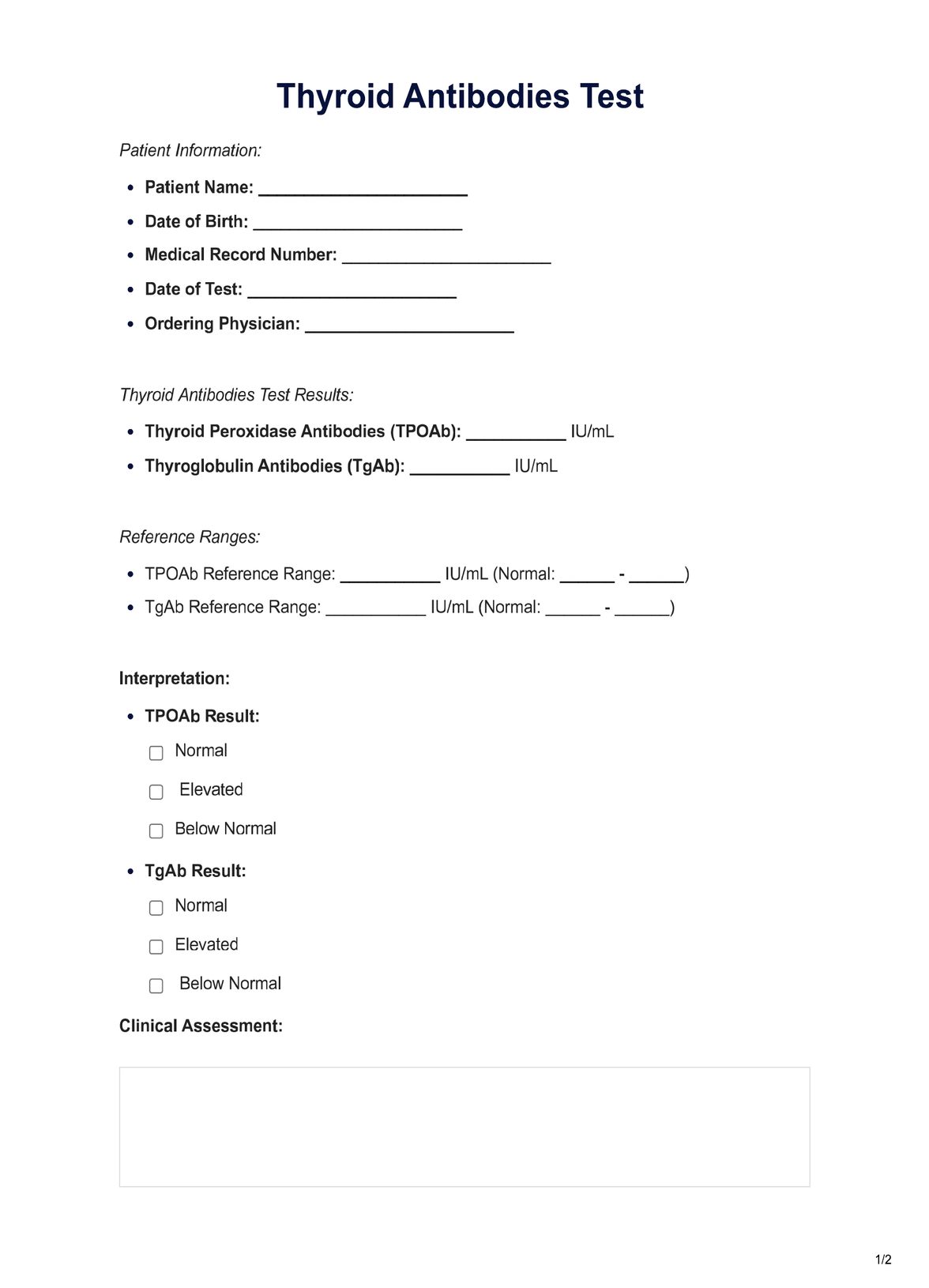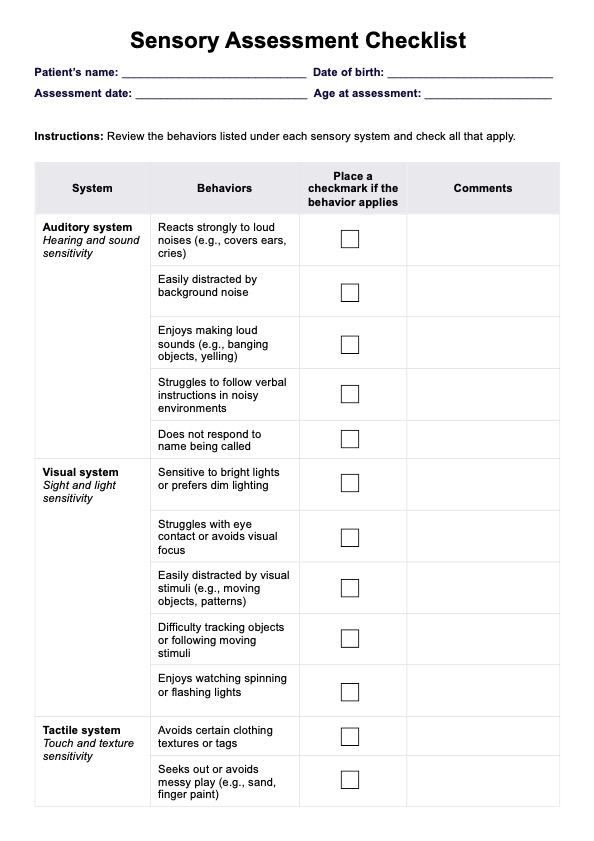Blood Type
Discover more about blood types, compatibility and donor information with our comprehensive guide. Access the PDF template now.


What is a Blood Type Chart?
A Blood Type Chart is a reference tool designed to help individuals understand more about their blood type, compatibility, and donor status. As a visual tool, the chart allows individuals and healthcare professionals, such as nurses, emergency department doctors, and blood phlebotomy technicians, to identify blood types. The chart provides information that can be used to determine how common or rare an individual's blood type is and their compatibility to donate or receive blood, plasma, and platelets for transfusions.
Critically, one in every seven patients admitted to the hospital requires blood donations (American Red Cross, 2023). Whether this is a red blood cell transfusion to increase hemoglobin and iron levels, platelet transfusions for individuals with cancer, or plasma transfusions for liver failure, blood donation is critical to saving lives. However, blood is constantly needed, particularly for emergency procedures, and not all blood types are compatible.
There are four major blood groups or blood types: the ABO blood group (blood types A, B, AB, and O) and the Rh-type blood group (positive or negative). An individual's blood group is inherited, meaning it is a combination of the DNA from both parents. Different blood types may be common or rare depending on the available supply. Rare blood types either have a common antigen or a combination of antigens missing, which means it is only present in 1 of 1000 people.
Blood Type Template
Blood Type Example
How does this Blood Type Chart template work?
Our Blood Type Chart is a practical resource for finding out more about your blood type, including your compatibility status for blood, plasma, and platelets with others. Here's how it works:
Step 1: Download the chart
Access our printable Blood Type Chart or download the PDF to reference your patient's blood type.
Step 2: Determine the blood type
Your patient must undergo a blood test to determine the blood type. Knowing their blood type helps doctors if they need a blood transfusion or organ transplant.
Step 3: Determine the compatibility
Once you have identified your patient's blood type, you can determine whether they are compatible with others who donate or receive blood, plasma, and platelets. Knowing blood types is crucial for safe transfusion in case blood is needed from someone else. In such cases, using a blood donation chart can help.
When would you use this Blood Type Chart?
Practitioners and individuals can use a Blood Type Chart in numerous scenarios, which may include:
Determining compatibility
Compatibility requires rigorous testing before transfusion, but knowing your blood type can help save time in urgent situations. Additionally, urgent care facilitators such as emergency department nurses can use the chart to determine blood, plasma, and platelet compatibility.
Blood transfusions
This chart can effectively determine blood type compatibility for urgent care practitioners such as emergency department doctors, nurses, or surgeons, allowing for an accurate cross-match for safe blood transfer.
Identifying availability
Certain blood types can be common or rare, depending on the antigens and various components in the blood, which may influence the availability of blood for procedures. An individual with O-negative blood has universal red cells, and someone with a type AB blood group is a universal plasma donor, essential for saving lives when blood type is unknown.
Testing in pregnancy
Identifying Rh blood type when a patient is pregnant is essential so healthcare providers can reduce the complexities of Rh incompatibility. Rh incompatibility may occur if the pregnant individual is Rh negative and the other parent is Rh positive.
Healthcare professionals and individuals can learn more about their blood type and compatibility with others using this resource.
Blood type identification
The blood type is genetically inherited from parents, made up of a combination of two important blood group systems: ABO system (blood types A, B, AB, and O) and the Rh type system (positive or negative). Therefore, individuals are likely to belong to one of the eight main blood types: O positive, O negative, A positive, A negative, B positive, B negative, AB positive, and AB negative. The most common blood type is O-positive blood, and O-negative blood is the universal blood type.
Here are several methods for healthcare professionals to determine a patient's blood type:
- Access patient records through their previous local healthcare provider, often containing blood type information.
- Schedule appointments with patients to discuss their blood type and other relevant medical information.
- Utilize official documents such as birth certificates, which may include blood type details.
- Refer patients for blood draws or tests through a general practitioner to determine blood type.
- Encourage patients to become blood donors. They can receive a donor card containing their blood type along with a donor ID.
Knowing a patient's blood type is essential to understanding more and determining compatibility with others.
Blood type compatibility
Blood type compatibility is vital in transfusions and pregnancy. When matching red blood cells, using the same blood type is crucial to avoid immune system reactions. If the patient receives blood cells that are not compatible, their immune system may attack them, causing severe complications. This reaction is especially significant with RhD-negative blood. Rh incompatibility occurs when an Rh-negative mother carries an Rh-positive fetus. The mother's immune system can produce antibodies against the fetus's red blood cells, leading to hemolytic disease, which can result in brain damage or newborn death.
Understanding the main blood groups, such as A, B, AB, and O, and other blood group systems, including the Rh factor, is essential. For instance, a blood sample from a person with a rare blood type, like RhD-negative blood, must be carefully cross-matched. Healthcare providers must also be vigilant in identifying whether the patient has Rh-negative blood to prevent complications.
Accurate identification of blood type compatibility ensures that transfusions and pregnancies are managed safely, preserving the patient’s health and preventing adverse immune system responses.
Blood donation
As a healthcare provider, you know the importance of blood donations, especially in emergencies. Ensuring that the donor matches the recipient's blood type is a priority. However, it is worth noting that when an individual decides to donate blood, various considerations are involved, such as age, weight, health conditions, and recent travel or medical history. To keep things in order, it's essential to highlight the significance of the blood type donation chart in ensuring safety and meeting the considerations above.
The Blood Type Donation Chart acts as a guide for healthcare professionals and blood donation organizations. It also aids in strategically allocating resources to meet patients' diverse needs. Moreover, the blood donor chart facilitates personalized outreach initiatives, encouraging individuals with specific blood types to contribute regularly to the blood supply.
Reference
American Red Cross. (2023). Importance of the blood supply. https://www.redcrossblood.org/donate-blood/how-to-donate/how-blood-donations-help/blood-needs-blood-supply.html
Commonly asked questions
The three rarest blood types are AB negative, B negative, and A negative. These blood types are relatively uncommon due to the fact that they have specific antigen combinations that make them less likely to be found in a large number of people.
Yes, AB+ and O+ are compatible blood types. Individuals with type AB+ have both A and B antigens on their red blood cells, making them able to receive blood from all other types (A, B, AB, and O).
No, O+ blood is not considered rare. In fact, it is the most common blood type, with approximately 38% of the world's population having this blood type. However, it can still be difficult to find a compatible donor for patients with O+ blood in certain situations, as they can only receive blood from other individuals with O+ or O- blood types.


